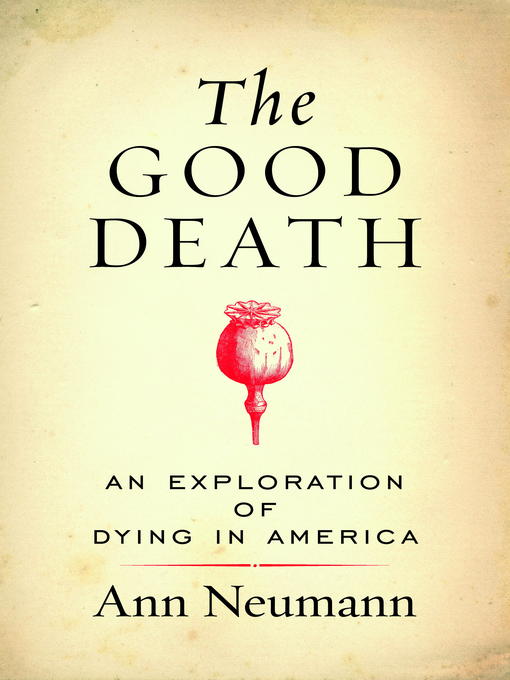When Ann Neumann’s father was diagnosed with non-Hodgkin’s lymphoma, she left her job and moved back to her hometown of Lancaster, Pennsylvania. She became his full-time caregiver—cooking, cleaning, and administering medications. When her father died, she was undone by the experience, by grief and the visceral quality of dying. Neumann struggled to put her life back in order and found herself haunted by a question: Was her father’s death a good death?
The way we talk about dying and the way we actually die are two very different things, she discovered, and many of us are shielded from what death actually looks like. To gain a better understanding, Neumann became a hospice volunteer and set out to discover what a good death is today. She attended conferences, academic lectures, and grief sessions in church basements. She went to Montana to talk with the attorney who successfully argued for the legalization of aid in dying, and to Scranton, Pennsylvania, to listen to “pro-life” groups who believe the removal of feeding tubes from some patients is tantamount to murder. Above all, she listened to the stories of those who were close to death.
What Neumann found is that death in contemporary America is much more complicated than we think. Medical technologies and increased life expectancies have changed the very definition of medical death. And although death is our common fate, it is also a divisive issue that we all experience differently. What constitutes a good death is unique to each of us, depending on our age, race, economic status, culture, and beliefs. What’s more, differing concepts of choice, autonomy, and consent make death a contested landscape, governed by social, medical, legal, and religious systems.
In these pages, Neumann brings us intimate portraits of the nurses, patients, bishops, bioethicists, and activists who are shaping the way we die. The Good Death presents a fearless examination of how we approach death, and how those of us close to dying loved ones live in death’s wake.
-
Creators
-
Publisher
-
Release date
February 16, 2016 -
Formats
-
Kindle Book
-
OverDrive Read
- ISBN: 9780807080634
- File size: 530 KB
-
EPUB ebook
- ISBN: 9780807080634
- File size: 530 KB
-
-
Languages
- English
-
Reviews
-
Kirkus
November 1, 2015
Journalist Neumann, a visiting scholar at the New York University Center for Religion and Media, takes an unflinching look at the reality of dying and end-of-life decisions. "Knowing death makes facing it bearable," writes the author in this chronicle of her six-year quest to come to terms with the death of her father. "There is no good death....It always hurts, both the dying and the left behind. But there is a good enough death." Determined to follow her father's wish to die at home, the author and her sister tried unsuccessfully to care for him with support from hospice. He had decided after a 10-year bout with cancer to stop treatment, but the quiet death he envisaged was not to be. His pain proved intractable, and he was hospitalized. Two years later, still struggling with grief in the aftermath of her father's death, the author decided to become a volunteer for hospice. As a lay visitor her task was to offer companionship to the dying. The expectation is that hospice patients will not live longer than six months--though some do. The aim is to make their last days as painless as possible, not to prolong their lives. Neumann writes movingly of the experiences she shared with the people she visited: an elderly musician suffering from Parkinson's disease who wanted to hold his guitar once again despite his inability to play it, an 80-year-old doctor suffering from lung cancer, hoping to write an autobiography, and more. She also deals with deeper questions: what constitutes death for a person on life support who cannot give informed consent for its removal; does assisted suicide, which she supports, devalue human life and possibly curtail the rights of the disabled? Neumann does not sugarcoat the harsh reality of dying. "It always hurts both the dying and the left behind," she writes. A valuable discussion of the complex issues involved in end-of-life care.COPYRIGHT(2015) Kirkus Reviews, ALL RIGHTS RESERVED.
-
Library Journal
December 1, 2015
The process and perception of death and dying in America are changing and are affected by many factors. Medical advancements can prolong life, visions of death are romanticized in literature and movies, and dying has become largely institutionalized, among other components. Journalist Neumann (Ctr. for Religion & Media, New York Univ.) seeks to reveal the changing nature of dying in America--the good, the bad, and the heartbreaking--through an examination of the political, cultural, and socioeconomic factors affecting this process. Topics include the history of hospice care; the political, legal, and economic effects of death on families and communities; medical overtreatment and autonomy; the staggering medical costs associated with prolonging life; the difficulty hope brings families and patients facing mortality, etc. The text is interspersed with Neumann's experiences volunteering in hospice care, including stories of the lives and deaths of those she came to know during her work and her interactions with members of the medical community, clergy, and families of the dying. VERDICT Readers seeking a refreshing examination of an ever-changing singular human experience will appreciate this concise and accessible volume that combines curiosity, modernity, and compassion.--Jennifer Harris, Southern New Hampshire Univ. Lib., Manchester
Copyright 2015 Library Journal, LLC Used with permission.
-
Formats
- Kindle Book
- OverDrive Read
- EPUB ebook
Languages
- English
Loading
Why is availability limited?
×Availability can change throughout the month based on the library's budget. You can still place a hold on the title, and your hold will be automatically filled as soon as the title is available again.
The Kindle Book format for this title is not supported on:
×Read-along ebook
×The OverDrive Read format of this ebook has professional narration that plays while you read in your browser. Learn more here.


